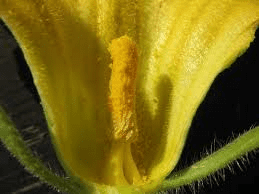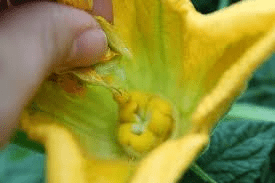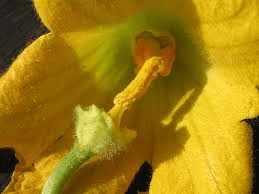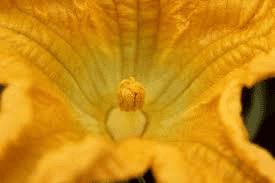Pumpkin stamens are an essential component of the pumpkin plant’s reproductive system. As part of the male flowers, stamens are responsible for producing and dispersing pollen, which is necessary for fertilizing female flowers and ensuring the development of pumpkin fruits. Understanding the structure and function of pumpkin stamens provides insight into the plant’s pollination process and overall reproductive biology.
Pumpkin plants (Cucurbita pepo) exhibit a monoecious flowering system, meaning they have separate male and female flowers on the same plant. Male flowers, which contain the stamens, are typically the first to appear on the pumpkin vine. These flowers grow on long, slender stems and are prominently located at the ends of the vines, making them easily accessible to pollinators such as bees.
Each male pumpkin flower contains several stamens, which are the reproductive organs responsible for producing pollen. A stamen consists of two main parts: the anther and the filament.
The anther is the pollen-producing structure, while the filament is the thin stalk that supports the anther. In pumpkin flowers, the anthers are often fused together, forming a central column within the flower. This fusion of anthers is a characteristic feature of many members of the Cucurbitaceae family.
The anthers produce and release pollen, which is a fine, yellow powder containing the male gametes. Pollen production in pumpkin flowers is prolific, ensuring that there is an ample supply for pollination. The pollen is designed to be easily transferred by pollinators, which is crucial for the fertilization of female flowers.
Pollinators, particularly bees, are attracted to the bright yellow color and nectar of the male pumpkin flowers. As they collect nectar, they brush against the anthers and pick up pollen on their bodies. When these bees visit female flowers to gather more nectar, they inadvertently deposit pollen onto the sticky stigma of the female flower. This transfer of pollen from the male stamen to the female pistil is known as pollination.
Successful pollination allows the pollen to travel down the style of the female flower to the ovary, where fertilization occurs. This fertilization process is essential for the development of pumpkin fruits. Without adequate pollination and fertilization, the female flowers will not produce pumpkins.
The structure of pumpkin stamens is adapted to maximize the efficiency of pollen transfer. The central column formed by the fused anthers creates a prominent target for pollinators, ensuring that they come into contact with the pollen. Additionally, the timing of flower opening and pollen release is synchronized with the activity patterns of pollinators, further enhancing the chances of successful pollination.
In addition to their biological role, pumpkin stamens can also be of interest in culinary contexts. While less commonly used than the petals, stamens can be included in edible flower preparations. However, it is generally the petals and other parts of the pumpkin flower that are more commonly consumed in various dishes.
Pumpkin stamens are crucial for the plant’s reproductive success. They produce and release pollen, which is transferred by pollinators to female flowers, enabling fertilization and fruit development. The structure and function of pumpkin stamens are finely tuned to maximize pollination efficiency, highlighting the intricate relationship between pumpkin plants and their pollinators.
The Economic Importance and Uses of Pumpkin Stamens

1. Food Ingredient: Pumpkin stamens can be used in culinary dishes. They are often used to add a unique flavor to soups and stews. Example: Pumpkin stamen soup.
2. Nutritional Value: Rich in nutrients, including vitamins A, C, and E, pumpkin stamens contribute to a balanced diet.
3. Traditional Medicine: Used in some traditional medicine practices to treat various ailments, such as inflammation and respiratory issues.
4. Agriculture: Growing pumpkins for their stamens can provide farmers with an additional source of income.
5. Animal Feed: Nutritious feed for livestock, such as chickens and rabbits. Example: Stamen-enriched chicken feed.
6. Culinary Delicacy: Considered a delicacy in certain cuisines, adding a unique touch to traditional dishes. Example: Stuffed pumpkin stamens in Mexican cuisine.
7. Eco-Friendly Agriculture: Pumpkin plants improve soil health, promoting sustainable agricultural practices.
8. Pollination Support: Pumpkin stamens attract pollinators, such as bees, aiding in the pollination of other crops.
9. Culinary Innovation: Chefs use pumpkin stamens to create innovative dishes. Example: Pumpkin stamen risotto.
10. Export Potential: Pumpkin stamens have a market in international gourmet food markets.
11. Income Diversification: Provides an additional revenue stream for farmers by selling stamens separately.
12. Seasonal Employment: Harvesting and processing stamens create job opportunities in rural areas.
13. Home Gardening: Easy to grow in home gardens, providing fresh produce for culinary uses.
14. Edible Landscaping: Pumpkin stamens can be used in edible landscaping, combining aesthetic appeal with food production.
15. Organic Farming: Pumpkin stamens can be grown organically, meeting the demand for organic products.
16. Agro-Tourism: Farms growing pumpkins for their stamens can attract tourists interested in agro-tourism.
17. Culinary Education: Used in cooking schools to teach about unique ingredients and cooking techniques.
18. Local Cuisine Promotion: Promoting the use of pumpkin stamens in local cuisine enhances cultural heritage and attracts food enthusiasts.
Read Also: Prevention and Methods of Controlling Coccidiosis Among Chickens
The Products and By-products That Can Be Derived From Pumpkin Stamens

1. Fresh Stamens: Sold directly in markets for culinary use. Example: Fresh stamens at farmer’s markets.
2. Dried Stamens: Used as a garnish or ingredient in various dishes. Example: Dried stamen powder.
3. Stamen Powder: Ground into a powder for use as a nutritional supplement. Example: Stamen powder in smoothies.
4. Stamen Oil: Extracted and used in cosmetics and cooking. Example: Stamen-infused oil.
5. Herbal Teas: Dried stamens can be used to make herbal teas. Example: Stamen tea.
6. Stamen Extract: Used in supplements and skincare products. Example: Stamen extract capsules.
7. Stamen Syrup: Made as a sweetener or flavoring agent. Example: Stamen syrup in desserts.
8. Stamen Paste: Blended into a paste for use in cooking. Example: Stamen paste in sauces.
9. Cosmetic Products: Used in lotions, creams, and other cosmetic products. Example: Stamen face cream.
10. Natural Dye: Produces natural dyes for fabrics and crafts. Example: Stamen dye for textiles.
11. Animal Feed Supplements: Added to animal feed for nutritional benefits. Example: Feed supplement for poultry.
12. Fertilizer: Composted stamens create nutrient-rich fertilizer. Example: Organic fertilizer from composted stamens.
13. Biofuel: Processed into biofuel. Example: Biogas production from stamen waste.
14. Flavoring Agents: Used to flavor foods and beverages. Example: Stamen flavoring in beverages.
15. Nutritional Supplements: Encapsulated as dietary supplements. Example: Stamen supplement capsules.
16. Antioxidant Source: Contains antioxidants used in health products. Example: Antioxidant-rich stamen extract.
17. Culinary Decor: Used to decorate dishes, enhancing visual appeal. Example: Stamen garnish on salads.
Read Also: Time and Methods of Fertilizer Application on Crops
Frequently Asked Questions (FAQ’s) About Pumpkin Stamens

1. What are pumpkin stamens?
Pumpkin stamens are the male reproductive parts of the pumpkin flower, responsible for producing pollen.
2. Are pumpkin stamens edible?
Yes, pumpkin stamens are edible and used in various dishes.
3. How do you prepare pumpkin stamens for cooking?
Wash thoroughly before use, removing any inedible parts.
4. What do pumpkin stamens taste like?
They have a mild, slightly sweet flavor.
5. Are there any health benefits to eating pumpkin stamens?
Yes, they are rich in vitamins A, C, and E, and contain important minerals.
6. Can pumpkin stamens be eaten raw?
Yes, but they are more commonly cooked to enhance their flavor and texture.
7. How do you store pumpkin stamens?
Fresh stamens should be stored in the refrigerator and used within a few days. Dried stamens can be stored in an airtight container.
8. Are pumpkin stamens used in traditional medicine?
Yes, in some cultures they are used to treat inflammation and respiratory issues.
9. Can pumpkin stamens be used in organic farming?
Yes, they can be grown organically and are often used in sustainable agricultural practices.
10. What dishes can I make with pumpkin stamens?
You can make a variety of dishes, including stuffed stamens, soups, and salads.
Read Also: Measurement and Definition of the term water yield






